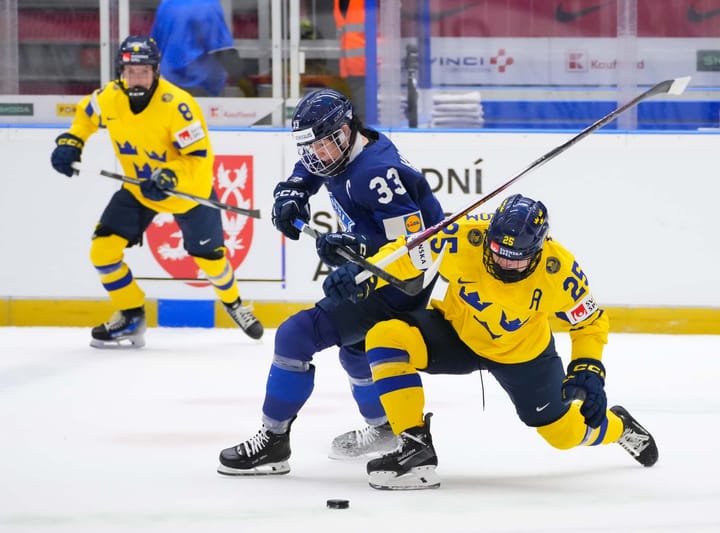Could Shenzhen KRS Vanke Rays join the Russian Women’s Hockey League?
With the closure of the CWHL, where could the Chinese team land?
It has been, as I’m sure you know, a fraught spring for women’s professional hockey. The sudden demise of the Canadian Women’s Hockey League cast six clubs and scores of players into limbo, and the subsequent development of the For The Game movement has created further uncertainty about what comes next for the women’s professional game in North America and indeed elsewhere.
Among the teams that have found themselves without a league to play in for the moment are the Shenzhen KRS Vanke Rays, the women’s team at KHL-based Chinese club Kunlun Red Star Beijing. Kunlun Red Star originally created two teams (Kunlun Red Star Shenzhen and Shenzhen Vanke Rays) to compete in the CWHL in 2017-18, in an effort to fast-track women’s hockey development in China in advance of the 2022 Winter Olympics in Beijing. After one season, the two teams merged, creating Shenzhen KRS Vanke Rays as the sole Chinese CWHL entrant. With that league’s sad departure from the scene, we must now ask where KRS Vanke Rays will head next.
The most obvious new home for the Chinese team is, for a number of reasons, the professional Russian Women’s Hockey League. The Zhenskaya Khokkeinaya Liga (Женская хоккейная лига, or ZhHL) is currently a seven-team circuit, with two teams in St. Petersburg and one apiece in Ufa, Nizhny Novgorod, Yekaterinburg, Krasnoyarsk, and the Moscow-region town of Dmitrov.
For the past few seasons, the league has been administered under the aegis of the KHL (it was previously run by the Russian Hockey Federation), and its current two-time defending champions, Agidel Ufa, are part of KHL club Salavat Yulaev Ufa. Other teams in the league are affiliated with lower-level men’s professional hockey clubs, with universities, and with regional sports authorities. In 2018-19, the ZhHL played a 36-game schedule that ran from September to February, followed by a two-round playoff. The schedule included, as every year, several breaks to accommodate Russian national teams’ participation in various tournaments.
There are many logistical reasons why having KRS Vanke Rays join the ZhHL makes perfect sense. To begin with, the Kunlun Red Star club is already deeply involved in Russian hockey at a number of levels. The club’s senior men’s team, Kunlun Red Star Beijing, plays in the KHL, which as already noted administers the Russian women’s league. Kunlun Red Star’s U20 men’s squad (Harbin-based KRS Heilongjiang) is in the top Russian junior league, the MHL, also run by the KHL. And the club’s professional men’s farm team, KRS-ORG Beijing, plays in Russia’s second-tier VHL. That last league is administered by the Russian Hockey Federation, which in 2017 signed a memorandum of cooperation with its Chinese counterpart to promote coaching, development, and so on in China. So there are lots of connections there already.
Even more intriguingly, the Zhenskaya Khokkeinaya Liga is has expressed clear and recent interest in increasing its number of teams; the league has a stated goal of getting to ten squads by 2022. Furthermore, the ZhHL is interested in including foreign teams, and there was much speculation a year ago about the possibility that Kazakh team Tomiris Astana, themselves part of KHL club Barys, might join the Russian circuit. A preliminary agreement on that move was reached, but the deal fell through in the end, likely for financial reasons.
Nor should geography prove much of an impediment to KRS Vanke Rays joining the Russian league. True, the distance from Shenzhen to St. Petersburg, which would be the team’s longest road trip, comes in at a tidy 7500 km. (4650 miles) each way. But that is still 3000 km. shorter than the Chinese teams’ shortest CWHL trip, to Calgary. And given that the Russian league’s schedule-makers already take travel into account — ZhHL teams make only one trip to each of their rivals each season, playing all of their road games against that opponent in the span of a few days — adding a team in China should not pose too many problems.
If distance is an issue, relocating KRS Vanke Rays from Shenzhen (on China’s south-east coast near Hong Kong and Macau) to Harbin in the north-east would mitigate matters. Such a move would put the team 1700 km . closer to Russia, and place KRS Vanke Rays in the heart of China’s traditional “hockey country, as nearly all of the Chinese women’s national team players come either from Harbin or from elsewhere in surrounding Heilongjiang Province.
Further to the geography of it all, and as an interesting historical side-note: the recent CWHL experience was not the first time that Chinese teams have gone far abroad for league play. For two seasons from 2005 to 2007, the Chinese women’s national team played a shortened schedule in the Finnish league as “Team China. That roster included, incidentally, 2018-19 KRS Vanke Rays defender and current Chinese national team captain Beiwei Yu. And Kunlun Red Star’s own men’s junior team played its first MHL season, 2017-18, based out of Riga, Latvia.
It would seem that there is a long list of very good reasons for Shenzhen KRS Vanke Rays to join the Russian Zhenskaya Khokkeinaya Liga for 2019-20, and that raises an interesting question: why has there been almost no public talk about such a move among the stakeholders (indeed, there has been not a peep)?
The answer, I think, is most likely that the Kunlun Red Star front office is waiting to see how things shake out in North America before making a decision on the women’s team’s future. While the ZhHL is a decent league overall and includes some excellent players (shout-out here to formidable Agidel Ufa forward Olga Sosina, to name just one), the calibre of play cannot be said to equal that of the North American pro circuits. It is entirely reasonable for the KRS top brass to want to wait to see if an opportunity to play against American or Canadian opposition will present itself.
In addition, the ZhHL’s import rules are stricter than the CWHL’s were; the CWHL allowed six foreign players per team, while in the Russian league the limit is two per club (Iink is a PDF, in Russian – the relevant section is Статья 44 at the bottom of page 29). Kunlun Red Star brought in a number of big-name non-Chinese signings for their CWHL teams (e.g. Finnish superstar goalie Noora Räty, and others), and the tighter restriction may not be particularly attractive to them (although it also may help get Chinese players more ice-time). For now, we wait for further developments.
However, the clock is ticking, both towards the 2019-20 hockey season and towards the 2022 Winter Olympics in Beijing. The Zhenskaya Khokkeinaya Liga’s team representatives will hold their pre-season organizational meeting likely sometime this month, as the 2018 gathering was held on June 28. A decision on any expansion for 2019-20 will need to be made at that time.
It is far from certain, but despite the lack of public talk about the possibility, I think there is a decent chance that we will see Shenzhen KRS Vanke Rays in the Russian league for next season, especially if the situation in North American women’s professional hockey remains unsettled.
Thank you for reading, and thank you to the The Ice Garden for the invitation to share some thoughts on this subject!
Patrick Conway is writes about Russian hockey and the KHL at Conway’s Russian Hockey. You can find him on Twitter at @ChunkletsHockey





Comments ()